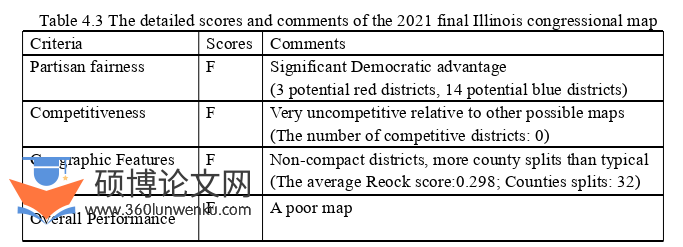CHAPTER ONE INTRODUCTION
1.1 Research Background and Significance
Gerrymandering,the manipulation of electoral district boundaries is one of thefeatures of American politics(Maisel,2007,p.23).In the 21st century when partisanpolitics in the United States of America are hyper-polarized,the malpractice isincreasingly intensified.Considering the original aspiration of American founding fathers,this perfect tool for politicians to screw national power is extremely undemocratic.TheFramers defined the newly established republic as a representative democracy,a form ofgovernment that promises to fulfill its responsibilities under control of the people throughelected delegations.Elections are therefore vital to American democracy,the most crucialof which is the election of the U.S.House of Representatives that is directly accountableto its constituencies(Su,2015,p.97).According to the U.S.Constitution,its members areelected every 2 years.Besides,states are delegated to decide how to hold the elections.Although the political party is not directly authorized to undertake redistricting,thepartisan affiliation of legislators in state government tends to involve the partisanship intocongressional elections.
Before 1842,some states chose districts while others preferred the general ticketsystem.The 1842 Act ended their coexistence and ushered in a new era of single-memberdistricts.Until 1846,all states adopted districts to elect U.S.House members.The numberof districts in each state is determined by its population and each district votes for 1representative.For example,in 2022 redistricting,California,the most populous state,isdivided into 52 districts,so it has 52 representatives.But Alaska,with small population,has only 1 district and 1 representative.Within a single district,there are candidates withdifferent or the same partisan affiliations running for the representatives in the primariesand the general elections.
.....................
1.2 Research Questions

英语论文怎么写
(2)What role do political parties(the Democrats and the Republicans)play in gerrymandering?
(3)How does gerrymandering distort American democracy?
The research is qualitative in nature.It will trace the history of gerrymandering andexplore its status quo in the U.S.via a critical examination of historical documents,courtrulings,relevant research projects conducted by Princeton University,Harvard Universityand Planscore.Based on the above analysis,it will utilize case studies to provide statisticalanalysis and tell the story about the role of gerrymandering and partisan politics inAmerican election.Additionally,to guarantee objectivity,the data source triangulationmethod will be adopted and the data are from Princeton Gerrymandering Project,PlanScore website and the Algorithm-Assisted Redistricting Methodology(ALARM)Project of Harvard University.
....................
CHAPTER TWO LITERATURE REVIEW
2.1 Methods for Identifying Gerrymandering
The first step in discussing gerrymandering is to identify it,and there iswell-established literature exploring quantitative measures that can be categorized eitheras compactness or as the vote to seat relationship.For compactness,the legal benchmarkof redistricting,the most utilized metrics include Reock score,Convex Hull ratio,thelength and width score,Polsby-Popper score and Boyce-Clark score.In addition,Kaufmanand others(2021)proposes two new methods,X-axis symmetry and the significantcorners scores(p.25).When it comes to the relationship between the vote share and theseat share,the following three ways deserve mentioning.The first family focuses ondisparities between the vote share and the seat share,among which the efficiency gapgarners the most heat.It is the result of dividing the margin of the two parties’wastedvotes,by the aggregate votes cast in an election(McGhee,2020,p.175).The logic is thatin addition to the proportional seat share,a fair map will give winners double rewards,twice vote margin for a seat margin(Tapp,2019,p.600).Elections with higher efficiencygaps are more likely to be gerrymandered.The second group prefers counterfactualsimulations.Symmetry and the mean-median difference are the representatives.Symmetrymeans a fair plan treating two parties equally given the same percentage of votes.Considering that it is almost impossible for two parties to receive the same number ofvotes in an election,this method is summarized as a counterfactual.In the scenario,different treatments of equal votes are linked to gerrymandered results.Well-knownsymmetry approaches are the partisan bias and responsiveness.
......................
2.2 Contributing Factors
Conventional wisdom ascribes gerrymandering to the political parties(the Democratsand the Republicans),political polarization,ethnic minorities,geographical distribution ofvoters,suppression of public opinions,the dual role of the U.S.House members and thedeficiency of the electoral systems,the U.S.Constitution and people’s limited way todefend the voting right.
McGann and others(2016)assert that one party control of the state governmentoffers a green light to gerrymandering(p.5).Until the 20th century,the Democratic Partydominated more states while in recent decades the Republicans has gradually gained theupper hand(Stephanopoulos,2017,p.2018).Wang Zhongyuan finds that polarization ofparty politics in the United States has largely inflamed gerrymandering(2023,p.47).Besides,partisan leanings of ethnic minorities and geographic distribution of politicalpopulation also fuel gerrymandering(Stephanopoulos,2017,p.2115).On the one hand,minorities are more inclined to support the Democrats by large margins in a limitednumber of districts,allowing the Republicans to compete for more districts and politicalpower nationally.On the other hand,Democratic voters are mainly from urban areas whilesupporters of the opposite party are located in a wider region including the suburban,exurban and rural areas.In this sense,The Republicans have the natural strength to winmore districts by narrow margins.Wang Xiyao(2022)blames gerrymandering for the longtradition of suppressing public opinions,the competition and compromise of constituencies under the influence of two-party politics,and the problem of the dualidentity of congressional representatives(p.23).Zhang Yi(2020)holds that the flaws inthe U.S.electoral system,the provisions in the U.S.Constitution that violate the oneperson,one vote principle and citizens’over-reliance on the judiciary when in comes todefend their voting right are major reasons for gerrymandering(p.56).
...............................
CHAPTER THREE GERRYMANDERING...............................9
3.1 Packing and Cracking...........................10
3.2 Origin of Terminology.....................................11
CHAPTER FOUR A CASE STUDY OF THE 2022 MID-TERM ELECTIONS......17
4.1 Profile of the 2020 Redistricting............................18
4.2 Profile of the 2022 midterm elections.............................20
CHAPTER FIVE GERRYMANDERING AND THE DISTORTION OFAMERICAN DEMOCRACY..............................54
5.1 Violating the Right to Vote.................................54
5.2 Creating Unresponsive Representatives and Congress.................................57
CHAPTER FIVE GERRYMANDERING AND THE DISTORTION OFAMERICAN DEMOCRACY
5.1 Violating the Right to Vote
The right to vote is the cornerstone of democracy.And the district map is the bridgebetween vote and democracy.If a map is fairly divided,every vote counts andrepresentatives can reflect the will of the people.Trapped in a gerrymandered map,it willbe difficult for those who are against the ruling party to vote effective ballots.In this way,the vote to seat translation,a critical bond between citizen’s preference and governmentrepresentation is manipulated.Ideally,the conversion would not benefit either party.Through gerrymandering,votes of the ruling party are translated into seats moreefficiently than the other.It indeed provides the party with more initiatives in its futurepolitical life.Then,these unjust majorities will use their power to disenfranchise targeted population,the vicious circle of the distortion of American democracy is thus formed(Tausanovitch&Root,2020,p.7).In other words,what matters is the district mapsinstead of the votes,especially when a map is drawn by the uniformly controlledlegislatures.As such,an election in which voters choose politicians has been replaced by amanipulation led by politicians.With the cooperation of the party brethren in statelegislatures,congressional officials can remove potentially opposition voters from theirdistricts.Under the guise of the selection technique,the results of elections appeared to bereasonable,but in fact they contravene the principle of one person,one vote.As shown inthe maps of the previous chapters,there are more deep blue or red districts than light blueor red ones.Even a layman in electoral politics can roughly predict the outcome of anelection based on the color of the map.

英语论文参考
CHAPTER SIX CONCLUSION
The preceding analysis shows that gerrymandering emerges as a result of partisaninterests and evolves with partisan politics.On the one hand,it is severe in times ofintense partisanship.On the other hand,periods of partisan harmony,like the Era of GoodFeelings are also times when gerrymandering subsides.Although the U.S.Constitutiondoes not authorize the political party to organize redistricting and the elections of U.S.House of Representatives,the partisan affiliation of state legislators is sufficient to turn thepartisan factor a force to be reckoned in redistricting and gerrymandering.As shown inchapter 4,partisan biases are more likely to appear in congressional maps drawn by aunified government in relative to plans from a split branch.In the former case,even if anindependent commission is in charge of redistricting,the bias in favor of the ruling party isinevitable.In the latter case,given the impact of the Republican Redistricting MajorityProject(REDMAP)in the 2010 redistricting,a pro-Republican bias is found.
In terms of distorting American democracy,gerrymandering is demonstrated in 3aspects.Firstly,it violates the democratic principle of one person,one vote by making theballots of certain citizens more influential than others which is a complete and utterinvasion of the right to vote.Secondly,it reduces the competitiveness of elections bycreating safe districts and produces unaccountable legislators and Congress that causewidespread discontent among the people.Given that Congress is directly responsible forthe people,the psychological gap between them reflects the failure of Americandemocracy.Lastly,gerrymandering and political polarization have promoted each other inrecent years.Against the backdrop of political polarization,battles and distrust betweenthe Democrats and the Republicans,and between Democratic and Republican supportershave intensified which contributes to the widespread of gerrymandering.Powered bygerrymandering,constituencies,as well as voters’choices,have become increasinglyhomogenized.
reference(omitted)
